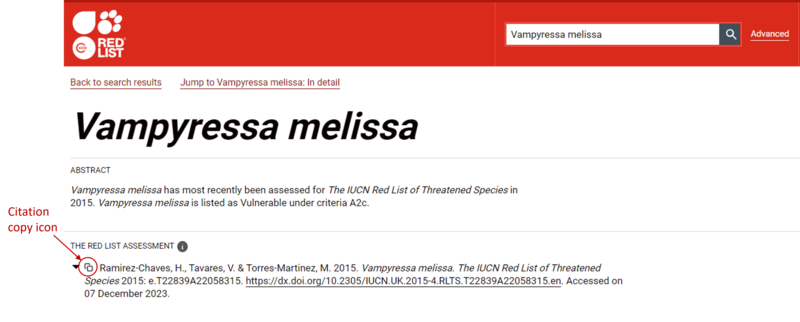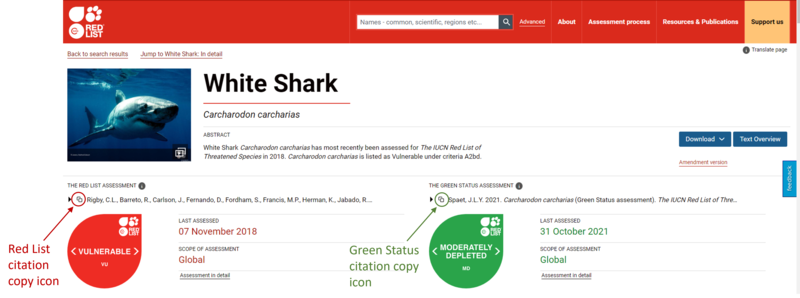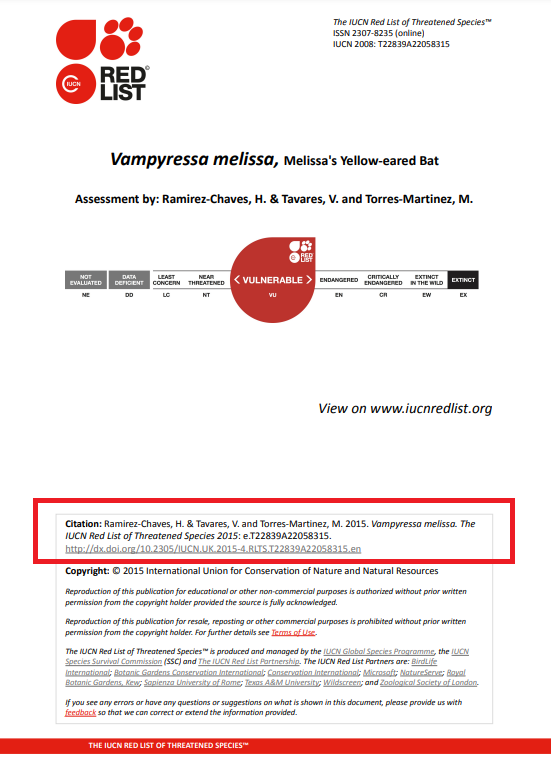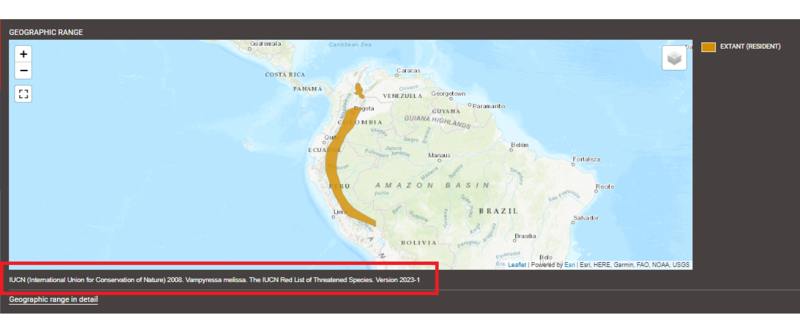Citing The IUCN Red List
Citing The IUCN Red List of Threatened Species™ in general
To cite The IUCN Red List of Threatened Species™ in general, users are advised to follow the format suggested below, changing the dates and version numbers as appropriate.
Within the text use "...IUCN (2024)..." or "...(IUCN 2024)...".
In a bibliography or reference list, cite The IUCN Red List as follows:
IUCN. 2024. The IUCN Red List of Threatened Species. Version 2024-1. https://www.iucnredlist.org. Accessed on [day month year].
Citing specific Red List or Green Status assessments published on The IUCN Red List
To cite an assessment published on The IUCN Red List, users are asked to treat it in the same way as they would a paper in an online scientific journal (The IUCN Red List is a registered online journal). The journal title is 'The IUCN Red List of Threatened Species', and the publication year is the volume number. If more than one Red List update was published within one year, the version number should be treated as the issue number: for example, versions 2022-1 and 2022-2 of the IUCN Red List should be referred to as "The IUCN Red List of Threatened Species 2022(1)" and "The IUCN Red List of Threatened Species 2022(2)" respectively.
The preferred citation appears at the top of every 'species' fact sheet. To copy an online assessment citation, click on the copy icon (shown within the red circle in the image below).

An increasing number of species have both Red List and Green Status assessments. Although these appear in the same fact sheet, they are separate assessments, and therefore have separate citations. To cite a Green Status assessment, please ensure you use the correct citation copy icon (shown in the image below).

Many published IUCN Red List assessments are available as downloadable PDF documents with DOIs, which are permanently retrievable. The citation format for a webpage version of the assessment differs from the citation for the PDF version. When citing a PDF version of the assessment, use the citation provided on the front page of the PDF (shown within the red box in the image below).

To cite specific Red List or Green Status assessments within text, use the assessment authors and the date the assessment was published. For example, when referring to the IUCN Red List assessment of Vampyressa melissa (see the image above), this should be cited as "Ramirez-Chaves et al. (2015)" or "(Ramirez-Chaves et al. 2015)".
Citing Spatial Data
Distribution maps (i.e., the spatial data) published on the IUCN Red List may not have been created at the same time as the current published assessment and often use data from sources outside of IUCN. The spatial data therefore have their own citations. Spatial data citations include the following information: name of the person or organisation providing the data (the 'authors'); year the spatial data were compiled; name of the taxon the mapped distribution refers to; an indication that the citation refers specifically to the spatial data; journal name, version, issue and URL; and date the website was accessed. Most of this information is provided below the map image in the assessment (shown within the red box in the image below).
To cite spatial data within text, use of the author(s) of the spatial data (in the image below, this is "IUCN (International Union for Conservation of Nature)"), and the date that these data were compiled (in the image below, this is "2008").

Examples of full citations for spatial data:
IUCN (International Union for Conservation of Nature) 2008. Vampyressa melissa (spatial data). The IUCN Red List of Threatened Species 2023(1). https://www.iucnredlist.org. Accessed on 27 June 2024.
IUCN (International Union for Conservation of Nature). 2019. Ochotona iliensis (spatial data). The IUCN Red List of Threatened Species 2023(1). https://www.iucnredlist.org. Accessed on 27 June 2024.
IUCN Grouper and Wrasse Specialist Group. 2018. Epinephelus striatus (spatial data). The IUCN Red List of Threatened Species 2023(1). https://www.iucnredlist.org. Accessed on 27 June 2024.
Wang, D. 2016. Ailuropoda melanoleuca (spatial data). The IUCN Red List of Threatened Species 2023(1). https://www.iucnredlist.org. Accessed on 27 June 2024.
